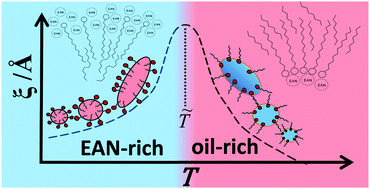Microstructure of ionic liquid (EAN)-rich and oil-rich microemulsions studied by SANS†
Abstract
In a previous study we investigated the phase behavior of microemulsions consisting of the ionic liquid ethylammonium nitrate (EAN), an n-alkane and a nonionic alkyl polyglycolether (CiEj). We found the same general trends as for the aqueous counterparts, i.e. a transition from an oil-in-EAN microemulsion via a bicontinuous microemulsion to an EAN-in-oil microemulsion with increasing temperature. However, unlike what happens in the corresponding aqueous systems, in EAN-in-oil microemulsions only a very small amount of EAN was detected by NMR-measurements. This is why we investigated the phase behavior and microstructure of EAN-rich n-dodecane-in-EAN microemulsions and oil-rich EAN-in-n-octane microemulsions. We found that the ionic liquid emulsification failure boundary has an extraordinarily small slope, which suggests that the amphiphilic film loses its ability to solubilize EAN with an increase in temperature by only a few degrees. The analysis of the small angle neutron scattering (SANS) curves unambiguously shows that this behavior is due to the fact that the EAN molecules form a substructure with a characteristic length scale of Λ ≈ 8 Å inside the EAN-in-oil droplets. In more detail, the analysis of the SANS data with the GIFT method revealed a transition from spherical to cylindrical structures approaching the respective critical endpoint temperatures. By using the respective form factors and combining them with a Gaussian spatial intensity distribution to account for the EAN sub-structure we were able to describe the scattering curves nearly quantitatively.



 Please wait while we load your content...
Please wait while we load your content...